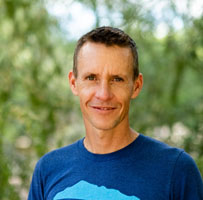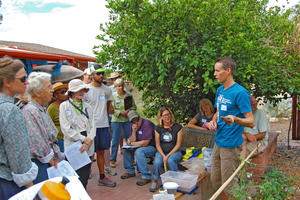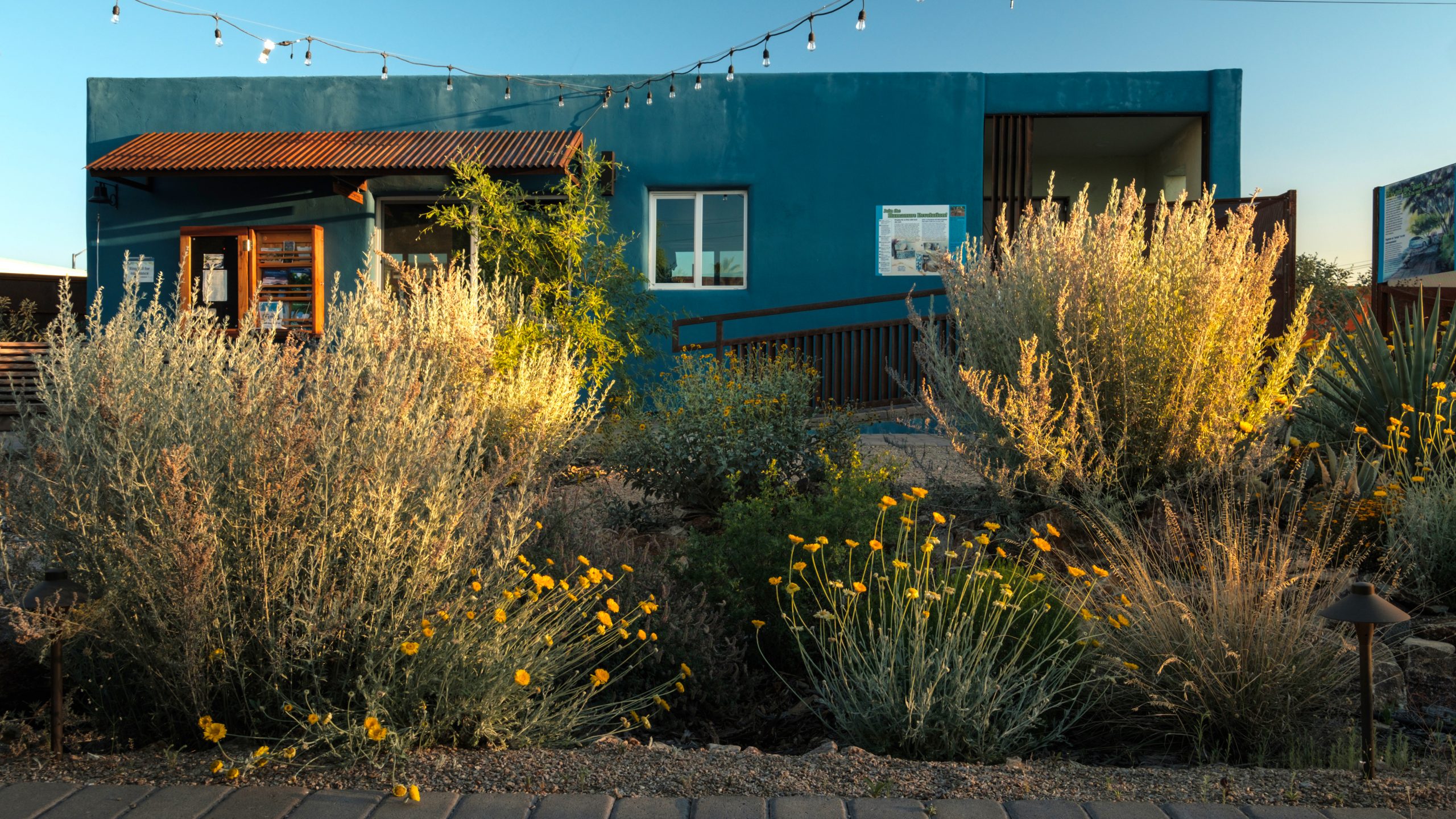This Guy Wants to Cut His City’s Water Use in Half
The offices of the Watershed Management Group in Tucson, Arizona. The native vegetation on the property is supported with rainwater capture.
___________________________
Nearly a decade ago, I was introduced to some of the amazing staff and volunteers at the Watershed Management Group in Tucson, Arizona. As they showed me around their “Living Lab and Learning Center” and I saw how they were capturing rainwater in tanks and garden areas, recycling grey water, creating compost from their toilets, and teaching thousands of kids and adults every year, I could feel their passion for creating a water-saving movement. It opened my eyes to the possibilities of living differently in the desert.
I had a chance to catch up with Catlow Shipek, one of WMG’s founders, this week. Given my renewed interest in rainwater harvesting and my lifelong interest in urban water conservation, I was anxious to ask him some questions.

Catlow Shipek, a founder of the Watershed Management Group in Tucson, Arizona
How long have you been promoting rainwater harvesting?
In 2005, we attended a free presentation offered by a local Pima County Library featuring Brad Lancaster, author of Rainwater Harvesting for Drylands and Beyond. Since then we have used water harvesting as one of many tools to connect community members with everything from their yards, to their downstream neighborhood arroyos, to our larger work to restore our downstream creeks and rivers.
What motivated you to establish the Watershed Management Group? How many people work or volunteer for WMG?
A handful of us were attending the University of Arizona’s Watershed Management graduate school program and we were searching for an outlet to apply what we were learning. We realized that there were very few opportunities or resources for community members to take action on their own property. We have slowly grown from that inception of a handful of founders in 2003 to currently 15 staff, a dozen or so docents, interns, and thousands of volunteers and supporters in Tucson, the Phoenix Valley, and the U.S.-Sonora, Mexico border region. We rely heavily on our volunteer network to restore, teach and steward our watersheds.
You live and work in a pretty dry area (Tucson AZ, in the Sonoran Desert). Your average rainfall is around 11 inches per year. Is it really possible for homeowners in your area to substantially reduce their use of public water supplies through rainwater harvesting?
Yes! Even in Tucson, a single inch of rain on your typical residential roof – a 1,000 square foot roof – can yield up to 600 gallons of water alone. This is a massively underestimated and underused resource at our fingertips. Our half-acre Living Lab and Learning Center in midtown Tucson is fully supported by rainwater in an average year for both indoor and outdoor needs. This includes supplying drinking water to staff and visitors, irrigating veggies and fruit trees, chickens, and a shady, native plant oasis throughout our campus.
By simply implementing a rain garden and planting native, low water use trees and pollinator plants we can support our landscapes with rainfall alone once established. No rain tank required! And, this can cut household water use by 30-40% on average!
What are the primary mechanisms of rainwater harvest (e.g., rainwater cisterns, etc) that you advocate for? Which have been most popular?
Rain gardens are by far the cheapest and most practical. Simply by forming our landscape contours to divert, collect, and soak up rainwater, we can grow shade trees to combat urban heat stress, diminish downstream flooding, support native edible food production and wildlife habitat, and in some areas of our watershed — help to replenish our groundwater. In 2021 we distributed 474 rain garden kits which we refer to as “Plant a Tree and Build Your Own Basin (BYOB) kits” (https://watershedmg.org/byob).
Rain tanks, typically 500 gallons or greater, are helpful if one desires a supply for indoor needs or supplemental irrigation for veggies and fruit trees.
Do you see interest in rainwater harvesting growing in your area?
Yes! Since the City of Tucson began offering an incentive program in 2012 for rainwater harvesting, we have seen interest steadily increase. And, with recent years that were very dry, coupled with a declared shortage on the Colorado River (Tucson receives an annual Colorado River supply), folks are more curious about how to help our community be more water secure and resilient. (editor’s note: the City of Tucson offers rebates of up to $2000 per household for rainwater harvesting)

Catlow teaching a workshop at WMG’s Living Lab and Learning Center
What policies or financial incentives or other strategies would be most beneficial in getting more people to harvest rainwater?
Beyond Tucson’s rainwater harvesting and greywater incentives, we are advocating for what we call a hydro-local approach across our Santa Cruz River Watershed. This means making use of local, renewable water sources like rainwater, greywater, and annually-renewed groundwater instead of sucking distant rivers and watersheds like the Colorado River dry. With this approach, we can increase our water resilience while recovering our groundwater levels to support renewed surface flows along many of our creeks and rivers.
To realize this hydro-local approach, we need to expand incentive programs to other groundwater users, establish environmental flow policies to secure groundwater levels and prevent overpumping, revise our new residential and commercial development codes, and continue to foster a conservation ethic to collectively steward our watershed health.
What other limitations dissuade homeowners from harvesting rainwater?
Typically cost is the primary issue, as most residents think rain tanks are the only solution and don’t realize the value of rain gardens. Many of our underserved neighborhoods lack the time or resources to learn and partake in rainwater harvesting. In addition, Tucson has a high population of renters, which adds additional complexity to implementing and caring for rainwater harvesting practices.
How affordable is it for homeowners to implement a rainwater harvesting system?
WMG piloted a rain garden kit this last year, where the cost of the kit was under $50 and provided at no cost to participants thanks to donor and grant funding. This Plant a Tree and Build Your Own Basin (BYOB) kit included a free 1-hour educational session, after which folks could take home a 5-gallon native shade tree, two 1-gallon native plants, woodchip mulch, and a BYOB instructional zine. Depending on a resident’s needs, means, and desires, costs can quickly climb from nearly free to thousands of dollars.
What is your dream for rainwater harvesting? What’s its potential?
Through collective stewardship—including water harvesting—across our community, we believe we can cut urban residential water use nearly in half while enhancing infiltration to replenish our aquifers. By doing this, we can shift to stewarding our local waters and reduce our reliance on imported Colorado River water. Collectively, we can restore our heritage of desert rivers locally and also be part of the solution for the Colorado River.
*A special thanks to Madeline Kiser for introducing me to Catlow and his team at WMG!

